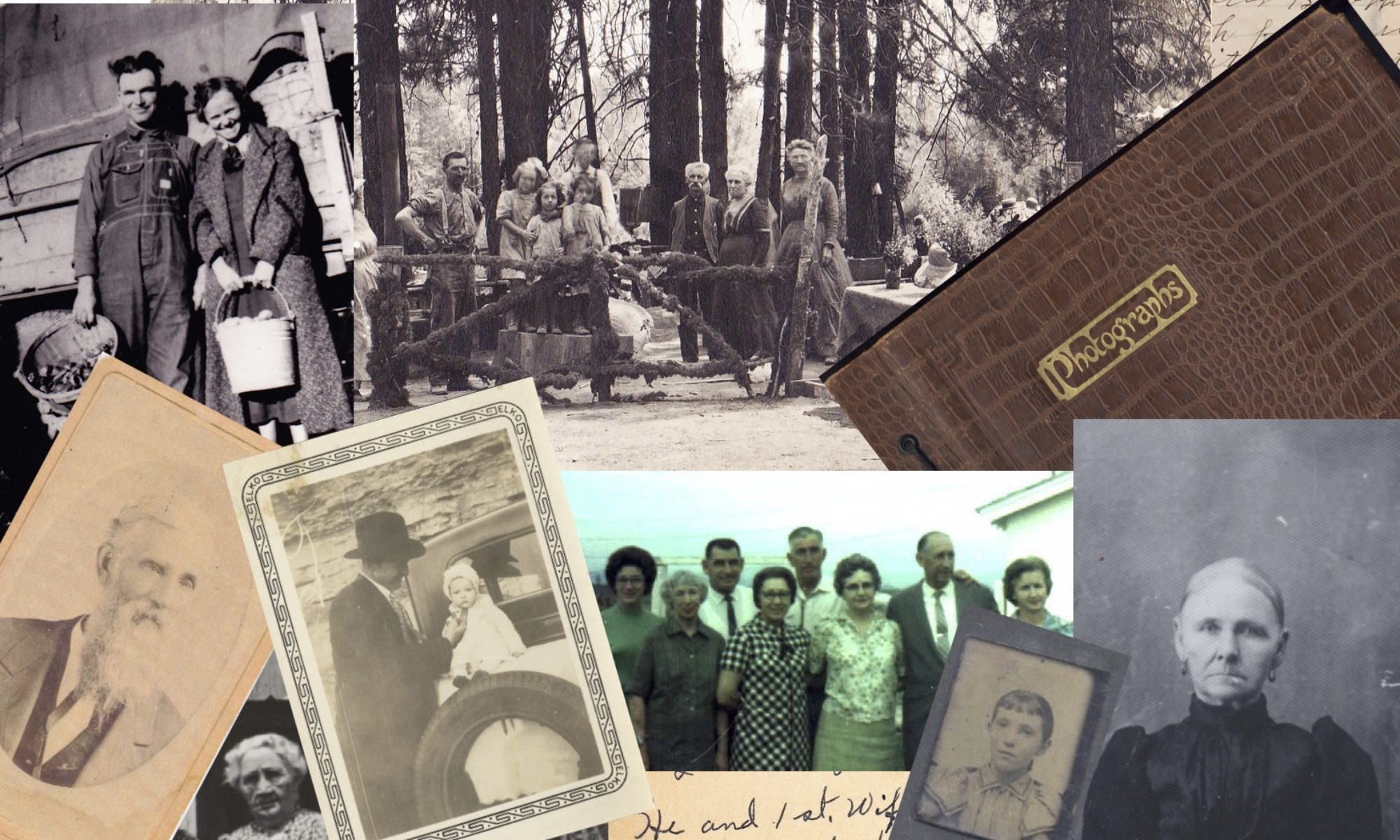Like any avid family history researcher or professional genealogist, I had known for years that the 1950 US census would be released on 1 April 2022. As the release date drew near, the number of articles, presentations, and blog posts about the 1950 census grew exponentially. Many people prepared to spend hours searching for their families starting at the stroke of midnight. I wasn’t among them. Why? I anticipated the website crashing under the weight of so many people trying to access the database. I might also have decided to go against the grain and not get caught up in the drama. Part of me wanted to learn from everyone else who went first. What I learned was that it was a rousing success so I set aside some time this morning to explore.
Background on the 1950 census
The 1950 census is the first census to be released with Machine Learning and Artificial Intelligence technology. A machine reviewed the census and created a searchable database of names based on interpretation of handwriting. That’s amazing! It’s a far cry from the days of using the Soundex and microfilm in a dark room at the National Archives poring over faded copies for hours. It’s not quite what researchers have become accustomed to: a census that is indexed and easily searchable on more than one website. That’s coming soon.
Based on early ideas about using the 1950 census, I was prepared to spend hours looking for the Enumeration District (ED) where I thought my family might be. The machine-derived index made that irrelevant for my first searches. The index will be updated with human effort over the upcoming months. Indexes for the first two states, Wyoming and Delaware, have been released at MyHeritage. Ancestry and FamilySearch also have the images available and are working on indexing. Each company has unique search capability and index. Whenever you can’t find your family in an index, before giving up or resorting to reading each page, check an index at a different website.
For the machine-derived index, keep in mind that enumerators recorded information by household. Typically, the surname appears next to the head of the household and usually a straight line or nothing is written for subsequent family members of the same surname. That meant I wouldn’t be looking for my father and mother who were children at the time. I would be searching for my grandfathers.
The challenge: How long would it take to find my parents?
The two surnames I was searching for, Davis and Johnson, are incredibly common and my family wasn’t living in rural or remote areas in 1950. I was prepared to slog my way through reading many pages before I found them. Before I began, I reviewed a useful article by Teresa Koch-Bostic which is available for members of the National Genealogical Society. Then I started my timer.
Finding Dad: 9 minutes and 26 seconds
Here are my steps and what I found:
- I reviewed my father’s timeline from my genealogy software, Reunion. I knew the family lived in Hollister, San Benito County, California. My dad graduated June 1952 from San Benito County High School.
- I entered the National Archives website and clicked on search.
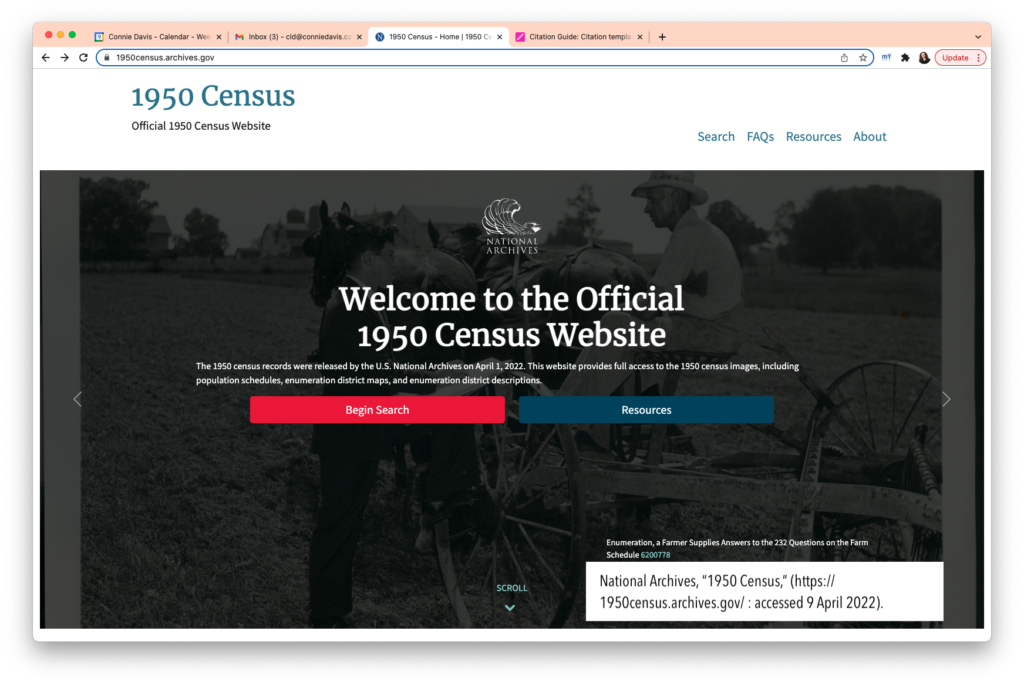
- I completed the information I had for state, county, and name, entering California, San Benito, Walt Davis (my grandfather’s name, the head of the household). I soon realized that Last Name, First Name order would be an improvement, but not crucial to success. I also noticed that the machine picked up the name David for Davis (see red arrow below), which is a good thing, since terminal letters in handwriting are often difficult to decipher. I switched my strategy and re-entered the name as Davis Walt. (His full name was Walton but he often went by Walt, and sometimes was confused with Walter, his father.)
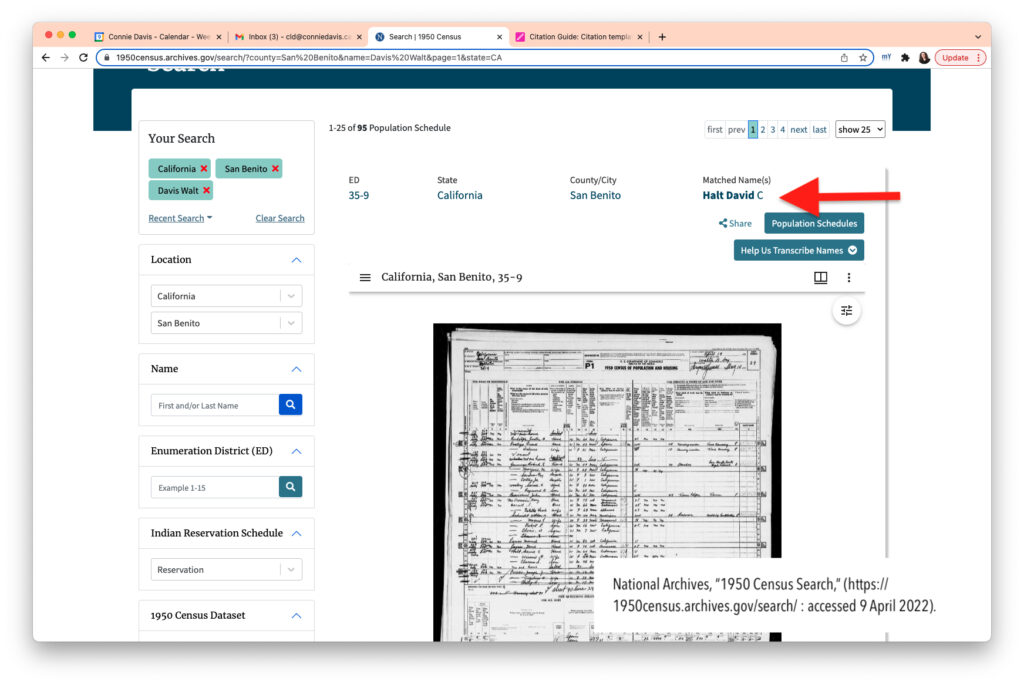
- I scrolled the results and the 26th name I encountered was my grandfather, Walton Davis. The family appeared on the bottom of page 1 and the top of page 2.

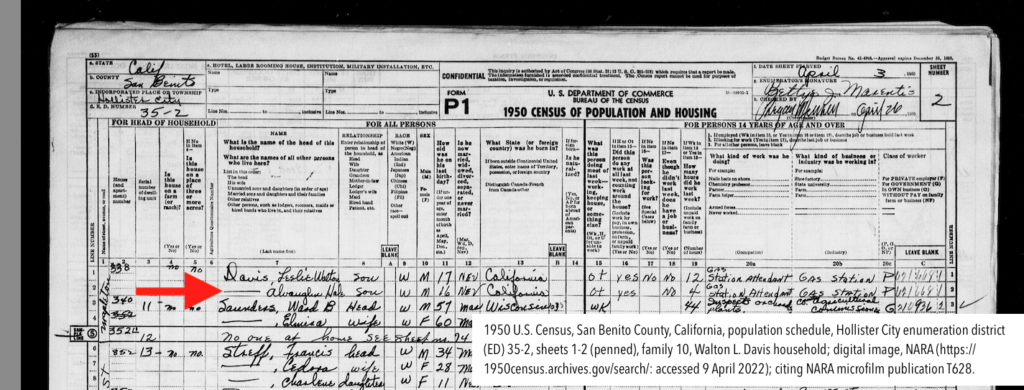
A close review of the page revealed the amount of information captured in the census. Although none of the information surprised me, seeing the names of my grandparents, uncle, and father, all gone now, made me smile. My grandmother’s stories of the auto dealership and garage sprang to mind and I could almost smell the oil and gas and see my grandfather disappointed with his challenges in receiving the type of cars he wanted to sell. I could picture my 16-year-old dad and his 17-year-old brother in coveralls with flat top haircuts, pumping gas and working in the garage.
My next step was to record the information in Reunion. The data entry took an additional 15 minutes because I created a new citation template for the 1950 census and added other useful information from the census to all the family member’s profiles. I updated my grandfather’s WikiTree biography and I will need to do the same for the rest of the family members.
Finding Mom: 1 minute and 47 seconds
I repeated the strategy for my mother, looking for my maternal grandfather, (in reverse order) “Johnson Lindell,” in Dyer County, Tennessee. Bingo! Six names down the list, there he was, along with his entire family (including my mother) at 420 Kist Avenue, the house I remember from my childhood (see arrow number 1, below). My great-uncle, his son and my great-grandmother all appear to be at the same house number, but I believe the second house was already on the property at that time. I’ll have to ask my uncle. My grandfather worked at the cotton mill down the street, as did my Aunt Earline, on line 22 (enumerated as Mildred E. Coleman.) A couple of their neighbors also worked at the mill. My great uncle A.W. (line 25, household 87) was delivering pottery. I grew up using the peach-shaped sugar bowl my mother received from his time driving the pottery truck.
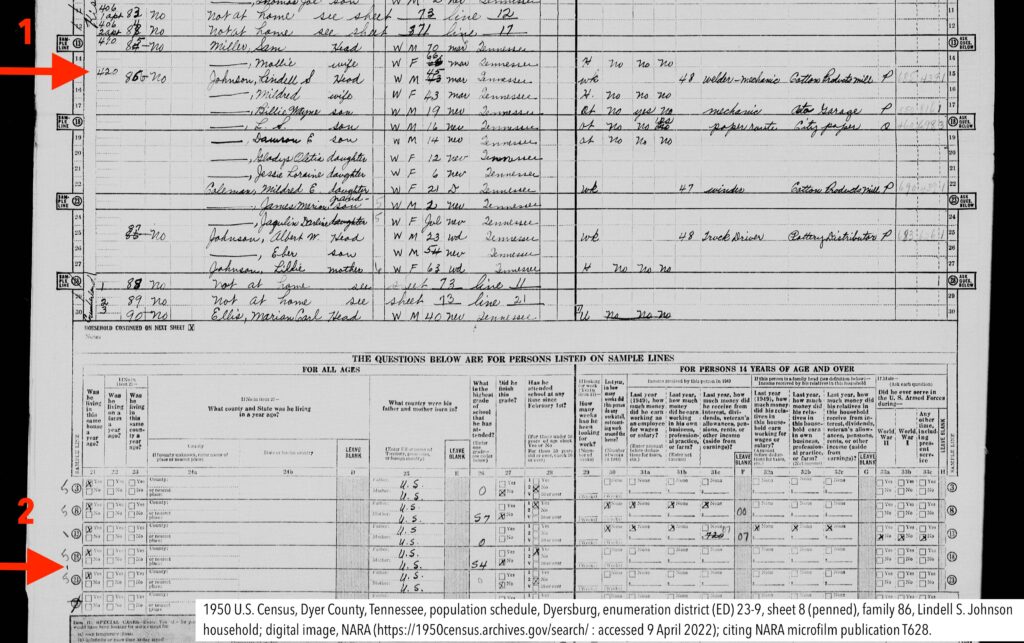
Two family members appear in the supplemental information at the bottom of the page (arrow #2). The census used a sampling strategy and enumerators recorded additional information for every fifth person on the census. My uncle L.S. was on line 18 and my cousin Jimmy was on line 23. The corresponding lines in the bottom section show information about residence in past year, nativity of parents, schooling, work, income, and military service. The information for Uncle L.S. is interesting. He was 16 years old and the information indicates he had completed 4th grade and did attend school in 1950. He is over 14 but the next section is blank, when the section header indicates it should be filled out for anyone 14 or older. His enumeration data above on line 18 noted he was working, delivering papers. Jimmy was two, so the information for him isn’t very revealing. Important information may be here in other situations. It could be the impetus for searching military records, understanding the family’s social situation, or the key to discovering an immigration pattern.
My examples were simple cases. I knew the exactly where the families were living and both were reasonably-sized communities. I knew the address of one place but I didn’t need it. If I were doing research on a family that relocated often and was in an urban setting, my results would have been different.
Your turn!
I’m looking forward to catching up on other family members in 1950. I don’t have any burning questions right now about my family in that time period, so it’s likely I will coordinate gathering 1950 census information as I improve the biographies of my family on WikiTree. And the data might be important for upcoming client work. I’m glad I took the few short minutes to explore the 1950 census. I’ll be back soon!
Happy searching!
